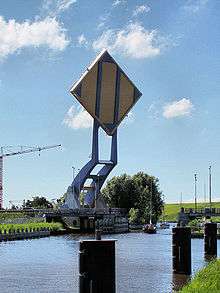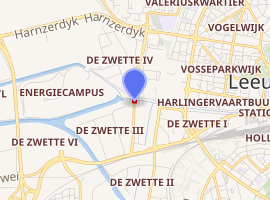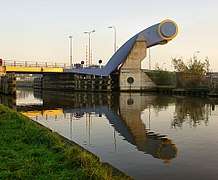Slauerhoffbrug
The Slauerhoffbrug (English: Slauerhoff Bridge) is a fully automatic bascule bridge (aka tail bridge)[1] in the city of Leeuwarden in the Netherlands. It is a road bridge that carries the Slauerhoffweg (named after J. Slauerhoff) over the Harlingervaart. It was completed in 2000.
Slauerhoffbrug | |
|---|---|
 Bridge raised for river traffic. | |
| Coordinates | 53.19850°N 5.76583°E |
| Carries | Traffic |
| Crosses | Harlingervaart |
| Locale | Leeuwarden, Netherlands |
| Other name(s) | the 'Flying Drawbridge' |
| Characteristics | |
| Design | Tail bridge[1] |
| Material | Iron and steel |
| Total length | 15 m[2] |
| Width | 15 m[2] |
| History | |
| Designer | Van Driel Mechatronica |
| Opened | 2000[3] |

| |
The bridge uses two arms to swing a section of road in and out of place. The deck is 15 m by 15 m.[2] It is painted in yellow and blue, representative of Leeuwarden's flag and seal.[1] This movable bridge is also known as the “Slauerhoffbrug ‘Flying’ Drawbridge”. One of the main designers is Emile Asari. A tail bridge can quickly and efficiently be raised and lowered from one pylon (instead of hinges). This quickly allows water traffic to pass while only briefly blocking road traffic.[1]
 Slauerhoffbrug in down position.
Slauerhoffbrug in down position.- Slauerhoffbrug is rising.
References
- Pinkerton, Lindsey (20 February 2009). "Strange Architecture: Bridge Design in the Netherlands". Popular Mechanics. Retrieved 14 August 2011.
- "Van Driel Mechatronica". Retrieved 6 January 2010.
- "Neatorama". Retrieved 6 January 2010.
External links

- Popular Mechanics article on the Slauerhoff bridge
- 4 Photos by Van Driel of the bridge up from different angles
- 3 Photos of bridge up
- 1 Photo of bridge up from road
- Slauerhoffbrug opening and closing
- timelapse of the bridge in action